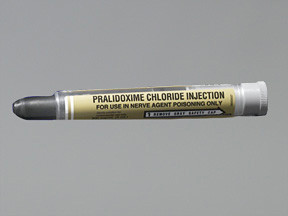PRALIDOXIME AUTO-INJECTOR - INJECTION
PHONETIC PRONUNCIATION: (PRAL-i-DOX-eem)
GENERIC NAME(S): pralidoxime chloride
Uses
USES: This medication is used with atropine to treat nerve agent poisoning by certain chemicals known as anticholinesterase agents (such as organophosphate pesticides such as parathion, "nerve gas" such as sarin, other nerve agents such as VX). Pralidoxime works by restoring the activity of a certain natural substance (cholinesterase) needed by nerves and muscles. Symptoms of nerve agent poisoning may include trouble breathing, headache, runny nose, drooling, vision changes, sweating, abdominal cramps, nausea, vomiting, diarrhea, muscle twitching/jerking, drowsiness, confusion, and seizures. Pralidoxime works mostly on the muscles (including breathing muscles) to decrease twitching, cramping, weakness, and paralysis. Another medication (atropine) is used to treat these and other symptoms of nerve agent poisoning such as slow/shallow breathing, wheezing, increased sweating/saliva, abdominal cramps, vomiting, and diarrhea.
How to use PRALIDOXIME AUTO-INJECTOR - INJECTION
HOW TO USE: Talk with your doctor about when you should use this product. Know the symptoms of nerve agent poisoning. (See also Uses section.) Learn how to properly inject this medication in advance so you will be prepared if you actually need to use it. Also teach another person what to do in case you cannot inject the medication yourself. This medication is given by injection into the muscle of the outer thigh, through clothing if necessary, as soon as possible after exposure to a nerve agent. Another drug (atropine) is usually injected first. Inject this drug (pralidoxime) after the atropine. Hold the injector firmly in place for 10 seconds. Massage the area of injection. To prevent further exposure to poison, the victim (and any others who treat or have contact with the victim) must right away put on protective equipment (such as breathing mask, gloves) and perform rapid decontamination procedures (such as removing contaminated clothing, washing skin and hair with sodium bicarbonate or alcohol). Pralidoxime is most effective when used within 24 hours after exposure. If symptoms of poisoning (such as increase in saliva, difficulty breathing, muscle weakness) are still present 15 minutes after the injections, you may give another dose of both atropine and pralidoxime. If needed, you may give a third set of injections 15 minutes later. Get medical help right away for follow-up treatment. Do not give more than 3 injections unless directed by a doctor. Dosage is based on your medical condition and poisoning symptoms.
Side Effects
Precautions
Interactions
Overdose
Images
Reviews
Faq for PRALIDOXIME AUTO-INJECTOR - INJECTION
- Pralidoxime auto-injector is used as an antidote for certain types of poisoning caused by exposure to pesticides or nerve agents.
- Pralidoxime auto-injector works by reactivating the enzyme that is responsible for breaking down these toxins in the body, thus reversing their harmful effects.
- Pralidoxime auto-injector is a pre-filled device that is injected into the thigh muscle or administered through clothing on the outer thigh. It is designed for rapid self-administration in emergency situations.
- Common side effects of Pralidoxime auto-injector may include headache, dizziness, blurred vision, dry mouth, nausea, and increased heart rate. These side effects are usually temporary and resolve on their own.
- The effect of Pralidoxime auto-injector generally lasts for about 1-2 hours. However, additional doses may be required depending on the severity of poisoning and the specific nerve agent involved.
- Pralidoxime auto-injector can be used in children, but the dosage is determined by their body weight and the specific circumstances of poisoning. It is important to follow the instructions of a healthcare professional in such cases.
- Pralidoxime auto-injector should be used in emergency situations where there is a high suspicion or confirmed exposure to pesticides or nerve agents. It is important to administer it as soon as possible to maximize its effectiveness.
- The use of Pralidoxime auto-injector during pregnancy or breastfeeding should be discussed with a healthcare professional. The potential benefits and risks need to be evaluated on a case-by-case basis.
- Yes, Pralidoxime auto-injector is a prescription medication and must be obtained through a healthcare professional. It is not available over the counter.
Disclaimer
IMPORTANT: HOW TO USE THIS INFORMATION: This is a summary and does NOT have all possible information about this product. This information does not assure that this product is safe, effective, or appropriate for you. This information is not individual medical advice and does not substitute for the advice of your health care professional. Always ask your health care professional for complete information about this product and your specific health needs.

No Reviews Yet